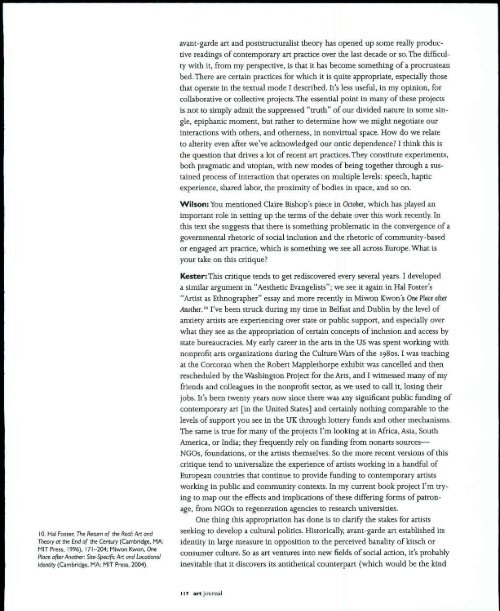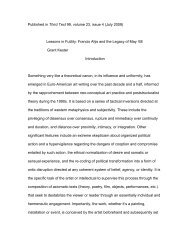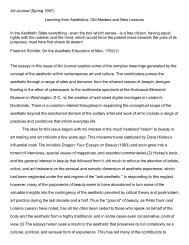Art Journal interview with Mick Wilson - Grant Kester
Art Journal interview with Mick Wilson - Grant Kester
Art Journal interview with Mick Wilson - Grant Kester
Create successful ePaper yourself
Turn your PDF publications into a flip-book with our unique Google optimized e-Paper software.
10. Hal Foster, The Return of the Real: <strong>Art</strong> and<br />
Theory at the End of the Century (Cambridge, MA:<br />
MIT Press, 1996), 171-204; Miwon Kwon, One<br />
Place after Another: Site-Specific <strong>Art</strong> and Locational<br />
Identity (Cambridge, MA: MIT Press, 2004).<br />
avant-garde art and poststructuralist theory has opened up some really productive<br />
readings of contemporary art practice over the last decade or so. The difficulty<br />
<strong>with</strong> it, from my perspective, is that it has become something of a procrustean<br />
bed. There are certain practices for which it is quite appropriate, especially those<br />
that operate in the textual mode I described. It's less useful, in my opinion, for<br />
collaborative or collective projects. The essential point in many of these projects<br />
is not to simply admit the suppressed "truth" of our divided nature in some single,<br />
epiphanic moment, but rather to determine how we might negotiate our<br />
interactions <strong>with</strong> others, and otherness, in nonvirtual space. How do we relate<br />
to alterity even after we've acknowledged our ontic dependence? I think this is<br />
the question that drives a lot of recent art practices. They constitute experiments,<br />
both pragmatic and utopian, <strong>with</strong> new modes of being together through a sustained<br />
process of interaction that operates on multiple levels: speech, haptic<br />
experience, shared labor, the proximity of bodies in space, and so on.<br />
<strong>Wilson</strong>: You mentioned Claire Bishop's piece in October, which has played an<br />
important role in setting up the terms of the debate over this work recently. In<br />
this text she suggests that there is something problematic in the convergence of a<br />
governmental rhetoric of social inclusion and the rhetoric of community-based<br />
or engaged art practice, which is something we see all across Europe. What is<br />
your take on this critique?<br />
<strong>Kester</strong>: This critique tends to get rediscovered every several years. I developed<br />
a similar argument in "Aesthetic Evangelists"; we see it again in Hal Foster's<br />
"<strong>Art</strong>ist as Ethnographer" essay and more recently in Miwon Kwon's One Place after<br />
Another.'" I've been struck during my time in Belfast and Dublin by the level of<br />
anxiety artists are experiencing over state or public support, and especially over<br />
what they see as the appropriation of certain concepts of inclusion and access by<br />
state bureaucracies. My early career in the arts in the US was spent working <strong>with</strong><br />
nonprofit arts organizations during the Culture Wars of the i98os. I was teaching<br />
at the Corcoran when the Robert Mapplethorpe exhibit was cancelled and then<br />
rescheduled by the Washington Project for the <strong>Art</strong>s, and I witnessed many of my<br />
friends and colleagues in the nonprofit sector, as we used to call it, losing their<br />
jobs. It's been twenty years now since there was any significant public funding of<br />
contemporary art [in the United States] and certainly nothing comparable to the<br />
levels of support you see in the UK through lottery funds and other mechanisms.<br />
The same is true for many of the projects I'm looking at in Africa, Asia, South<br />
America, or India; they frequently rely on funding from nonarts sources-<br />
NGOs, foundations, or the artists themselves. So the more recent versions of this<br />
critique tend to universalize the experience of artists working in a handful of<br />
European countries that continue to provide funding to contemporary artists<br />
working in public and community contexts. In my current book project I'm trying<br />
to map out the effects and implications of these differing forms of patronage,<br />
from NGOs to regeneration agencies to research universities.<br />
One thing this appropriation has done is to clarify the stakes for artists<br />
seeking to develop a cultural politics. Historically, avant-garde art established its<br />
identity in large measure in opposition to the perceived banality of kitsch or<br />
consumer culture. So as art ventures into new fields of social action, it's probably<br />
inevitable that it discovers its antithetical counterpart (which would be the kind<br />
117 art journal




